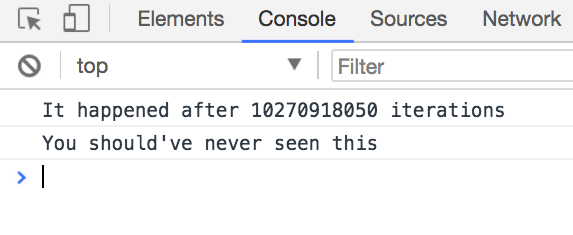JavaScript
a == a +1
In JavaScript, there are no integers but only Numbers, which are implemented as double precision floating point numbers.
It means that if a Number a is large enough, it can be considered equal to four consecutive integers:
a = 100000000000000000
if (a == a+1 && a == a+2 && a == a+3){
console.log("Precision loss!");
}
True, it's not exactly what the interviewer asked (it doesn't work with a=0), but it doesn't involve any trick with hidden functions or operator overloading.
Other languages
For reference, there are a==1 && a==2 && a==3 solutions in Ruby and Python. With a slight modification, it's also possible in Java.
Ruby
With a custom ==:
class A
def ==(o)
true
end
end
a = A.new
if a == 1 && a == 2 && a == 3
puts "Don't do this!"
end
Or an increasing a:
def a
@a ||= 0
@a += 1
end
if a == 1 && a == 2 && a == 3
puts "Don't do this!"
end
Python
You can either define == for a new class:
class A:
def __eq__(self, who_cares):
return True
a = A()
if a == 1 and a == 2 and a == 3:
print("Don't do that!")
or, if you're feeling adventurous, redefine the values of integers:
import ctypes
def deref(addr, typ):
return ctypes.cast(addr, ctypes.POINTER(typ))
deref(id(2), ctypes.c_int)[6] = 1
deref(id(3), ctypes.c_int)[6] = 1
deref(id(4), ctypes.c_int)[6] = 1
print(1 == 2 == 3 == 4)
# True
It might segfault, depending on your system/interpreter.
The python console crashes with the above code, because 2 or 3 are probably used in the background. It works fine if you use less-common integers:
>>> import ctypes
>>>
>>> def deref(addr, typ):
... return ctypes.cast(addr, ctypes.POINTER(typ))
...
>>> deref(id(12), ctypes.c_int)[6] = 11
>>> deref(id(13), ctypes.c_int)[6] = 11
>>> deref(id(14), ctypes.c_int)[6] = 11
>>>
>>> print(11 == 12 == 13 == 14)
True
Java
It's possible to modify Java Integer cache:
package stackoverflow;
import java.lang.reflect.Field;
public class IntegerMess
{
public static void main(String[] args) throws Exception {
Field valueField = Integer.class.getDeclaredField("value");
valueField.setAccessible(true);
valueField.setInt(1, valueField.getInt(42));
valueField.setInt(2, valueField.getInt(42));
valueField.setInt(3, valueField.getInt(42));
valueField.setAccessible(false);
Integer a = 42;
if (a.equals(1) && a.equals(2) && a.equals(3)) {
System.out.println("Bad idea.");
}
}
}


==when you mean===, have a coding standard that bans non-ASCII variable names, and have a linting process which enforces the previous two morals.